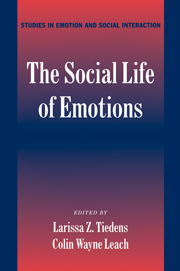Introduction: A World of Emotion
Published online by Cambridge University Press: 01 April 2011
Summary
In every human attitude for example in emotion … – we shall find the whole of human reality, since emotion is the human reality which assumes itself and which, “aroused,” “directs” itself toward the world. […] There is, in effect, a world of emotion.
Jean-Paul SartreIn agreement with Sartre (1948), many theorists have argued that emotion is a way in which people imbue the world with meaning (see Abu-Lughod & Lutz, 1990; Harré, 1986; Osgood, 1971). Although this perspective emphasizes the individual as making the social world meaningful through emotion, it also suggests that individual emotion is necessarily about people's experience of the world. Thus, many contemporary thinkers argue that understanding emotion is essential to understanding social experience and behavior. For example, in the past fifteen years, the sociology of emotion has grown into a vibrant subfield (for reviews, see Kemper, 1990; Thoits, 1989) with examinations of emotion in the context of social relationships (e.g., Scheff, 1994), social status (e.g., Kemper, 2001), and social movements (e.g., Goodwin, Jasper, & Polletta, 2001). The anthropology of emotion has also grown in this same period and offers a challenge to individualistic and universalistic approaches to emotion (for reviews, see Lutz & Abu-Lughod, 1990; Lutz & White, 1986). Political scientists have also become fascinated with the way in which emotions influence political behaviors, including voting, policy support, and party support (e.g., Goodwin et al., 2001; Iyengar et al., 1984; Kinder & Sanders, 1996).
- Type
- Chapter
- Information
- The Social Life of Emotions , pp. 1 - 16Publisher: Cambridge University PressPrint publication year: 2004
References
- 21
- Cited by

